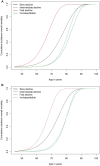Trajectories of kidney function and risk of mortality
- PMID: 37649343
- PMCID: PMC10749765
- DOI: 10.1093/ije/dyad111
Trajectories of kidney function and risk of mortality
Abstract
Background: We aimed to identify patterns within the rate of kidney function decline, determinants of these patterns and their association with all-cause mortality risk in the general population.
Methods: Participants aged ≥ 45 years with at least one assessment of creatinine-based estimated glomerular filtration rate (eGFR) taken between 1997 and 2018 were selected from a population-based cohort study. Analyses were performed using several distinct latent class trajectory modelling methods. Cumulative incidences were calculated with 45 years of age as the starting point.
Results: In 12 062 participants (85 922 eGFR assessments, mean age 67.0 years, 58.7% women, median follow-up 9.6 years), four trajectories of eGFR change with age were identified: slow eGFR decline [rate of change in mL/min/1.73 m2 per year (RC), -0.9; 95% CI, -0.9 to -0.9; reference group], intermediate eGFR decline (RC, -2.5; 95% CI, -2.7 to -2.5) and fast eGFR decline (RC, -4.3; 95% CI, -4.4 to -4.1), and an increase/stable eGFR (RC, 0.3; 95% CI, 0.3 to 0.4). Women were more likely to have an increase/stable eGFR [odds ratio (OR), 1.94; 95% CI, 1.53 to 2.46] whereas men were more likely to have a fast eGFR decline (OR, 1.86; 95% CI, 1.33 to 2.60). Participants with diabetes, cardiovascular disease (CVD) or hypertension were more likely to have an intermediate or fast eGFR decline. All-cause mortality risks (cumulative incidence at age of 70 years) were 32.3% (95% CI, 21.4 to 47.9, slow eGFR decline), 6.7% (95% CI, 3.5 to 12.4, intermediate eGFR decline), 68.8% (95% CI, 44.4 to 87.8, fast eGFR decline) and 9.5% (95% CI, 5.5 to 15.7, increase/stable eGFR).
Conclusion: Sex, hypertension, diabetes and CVD were identified as trajectory membership determinants. Having fast eGFR decline was associated with the highest risk of all-cause mortality, highlighting the need for extensive monitoring and prevention of kidney function decline in individuals at risk of having fast eGFR decline.
Keywords: Estimated glomerular filtration rate; latent class modelling; mortality; risk factors; trajectories.
© The Author(s) 2023. Published by Oxford University Press on behalf of the International Epidemiological Association.
Conflict of interest statement
None declared.
Figures


Similar articles
-
Estimated GFR Trajectories of People Entering CKD Stage 4 and Subsequent Kidney Disease Outcomes and Mortality.Am J Kidney Dis. 2016 Aug;68(2):219-228. doi: 10.1053/j.ajkd.2016.02.039. Epub 2016 Mar 4. Am J Kidney Dis. 2016. PMID: 26948835
-
Periodontal Disease and Risks of Kidney Function Decline and Mortality in Older People: A Community-Based Cohort Study.Am J Kidney Dis. 2015 Aug;66(2):223-30. doi: 10.1053/j.ajkd.2015.01.010. Epub 2015 Mar 6. Am J Kidney Dis. 2015. PMID: 25747403
-
Kidney Function as Risk Factor and Predictor of Cardiovascular Outcomes and Mortality Among Older Adults.Am J Kidney Dis. 2021 Mar;77(3):386-396.e1. doi: 10.1053/j.ajkd.2020.09.015. Epub 2020 Nov 14. Am J Kidney Dis. 2021. PMID: 33197533
-
Kidney function trajectories, associated factors, and outcomes in multiethnic Asian patients with type 2 diabetes.J Diabetes. 2024 Sep;16(9):e13523. doi: 10.1111/1753-0407.13523. Epub 2024 Jan 2. J Diabetes. 2024. PMID: 38169157 Free PMC article.
-
Progression of diabetic kidney disease and trajectory of kidney function decline in Chinese patients with Type 2 diabetes.Kidney Int. 2019 Jan;95(1):178-187. doi: 10.1016/j.kint.2018.08.026. Epub 2018 Nov 8. Kidney Int. 2019. PMID: 30415941
Cited by
-
Push toward pre-emptive kidney transplantation - for sure?Clin Kidney J. 2024 Dec 9;17(12):sfae335. doi: 10.1093/ckj/sfae335. eCollection 2024 Dec. Clin Kidney J. 2024. PMID: 39698373 Free PMC article. Review.
-
Longitudinal studies: focus on trajectory analysis in kidney diseases.J Nephrol. 2025 Mar;38(2):435-444. doi: 10.1007/s40620-024-02167-4. Epub 2024 Dec 7. J Nephrol. 2025. PMID: 39644432 Review.
-
Uraemic burden index: a novel predictor of pre-emptive kidney transplant outcome.Clin Kidney J. 2025 May 13;18(7):sfaf129. doi: 10.1093/ckj/sfaf129. eCollection 2025 Jul. Clin Kidney J. 2025. PMID: 40735146 Free PMC article.
References
-
- Kidney Disease: Improving Global Outcomes (KDIGO) CKD Work Group . KDIGO 2012 clinical practice guideline for the evaluation and management of chronic kidney disease. Kidney Int 2013;3:1–150. - PubMed
-
- Eriksen BO, Ingebretsen OC.. The progression of chronic kidney disease: a 10-year population-based study of the effects of gender and age. Kidney Int 2006;69:375–82. - PubMed
-
- Tangri N, Stevens LA, Griffith J. et al. A predictive model for progression of chronic kidney disease to kidney failure. JAMA 2011;305:1553–59. - PubMed
MeSH terms
Grants and funding
LinkOut - more resources
Full Text Sources
Medical
Research Materials
Miscellaneous

